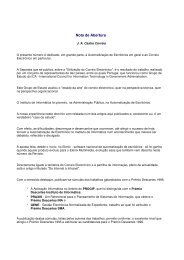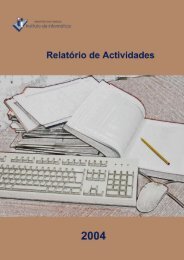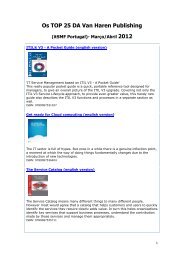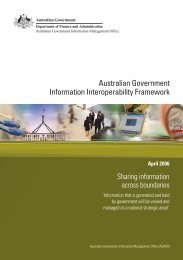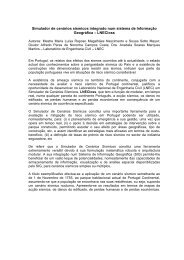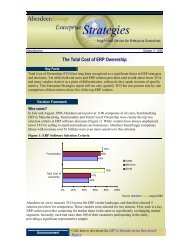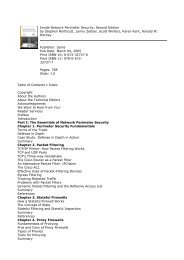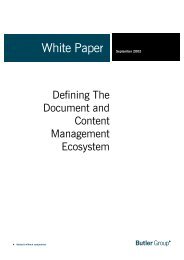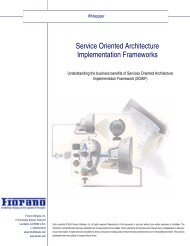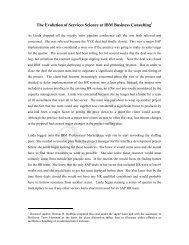OECD Peer Review of E-Government in Denmark - ePractice.eu
OECD Peer Review of E-Government in Denmark - ePractice.eu
OECD Peer Review of E-Government in Denmark - ePractice.eu
You also want an ePaper? Increase the reach of your titles
YUMPU automatically turns print PDFs into web optimized ePapers that Google loves.
Figure 7.3 Mechanisms for assess<strong>in</strong>g user demand for e-government<br />
70<br />
60<br />
50<br />
40<br />
%<br />
30<br />
20<br />
10<br />
0<br />
Web hits Customer surveys <strong>Government</strong> wide statistics Electronic feedback mechanisms<br />
Number <strong>of</strong> responses (as %)<br />
Source: <strong>OECD</strong> E-<strong>Government</strong> Survey: <strong>Denmark</strong>.<br />
Organisations’ experience with user demand<br />
As already noted, despite the fact that <strong>Denmark</strong> is a leader <strong>in</strong> provision <strong>of</strong> onl<strong>in</strong>e <strong>in</strong>formation and<br />
services, the vast majority <strong>of</strong> respondents to the <strong>OECD</strong> survey reported that the biggest drive for<br />
e-government <strong>in</strong> their organisation was com<strong>in</strong>g either from the government (57%) or from with<strong>in</strong> the<br />
organisation (35%). Less than 5% <strong>of</strong> respondents <strong>in</strong>dicated that the biggest drive was com<strong>in</strong>g from<br />
citizens, and even fewer stated that bus<strong>in</strong>esses provided the biggest drive. This an <strong>in</strong>dication <strong>of</strong> an<br />
<strong>in</strong>nately user-focused public sector be<strong>in</strong>g prompted to use e-government to move further <strong>in</strong> this<br />
direction as a result <strong>of</strong> government policy and strategies, rather than <strong>in</strong> response to external demand.<br />
Constra<strong>in</strong>ts on demand<br />
Survey respondents identified a range <strong>of</strong> possible constra<strong>in</strong>ts on demand for e-government, the<br />
two most important (i.e. rated as be<strong>in</strong>g “very important”) be<strong>in</strong>g: 1) a lack <strong>of</strong> service l<strong>in</strong>k<strong>in</strong>g or<br />
<strong>in</strong>tegration, whereby organisations do not work <strong>in</strong> an <strong>in</strong>tegrated fashion; and 2) user perceptions that<br />
e-government service delivery is not sufficiently advanced <strong>in</strong> terms <strong>of</strong> <strong>of</strong>fer<strong>in</strong>g possibilities for onl<strong>in</strong>e<br />
<strong>in</strong>teraction or transactions. These constra<strong>in</strong>ts were each rated as be<strong>in</strong>g very important by 9% <strong>of</strong> survey<br />
respondents, with the latter seen as the largest constra<strong>in</strong>t overall, be<strong>in</strong>g regarded as important to some<br />
degree by 63% <strong>of</strong> respondents (see Figure 7.4 below). This is a notable survey result because, despite<br />
<strong>in</strong>dications that government could take a more user-focused approach to understand<strong>in</strong>g the demand for<br />
e-government, identification <strong>of</strong> both constra<strong>in</strong>ts reflects an awareness <strong>of</strong> the fact that user-focused<br />
e-government <strong>in</strong>volves provision <strong>of</strong> services <strong>in</strong> ways that are more sophisticated than simply post<strong>in</strong>g<br />
<strong>in</strong>formation on Web pages and/or allow<strong>in</strong>g forms to be filled out onl<strong>in</strong>e.<br />
127



